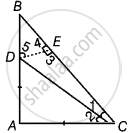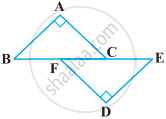Advertisements
Advertisements
प्रश्न
ABC is a right triangle such that AB = AC and bisector of angle C intersects the side AB at D. Prove that AC + AD = BC.
उत्तर
Given: In right angled ΔABC, AB = AC and CD is the bisector of ∠C.
Construction: Draw DE ⊥ BC.
To prove: AC + AD = BC
Proof: In right angled ΔABC, AB = AC and BC is a hypotensue ...[Given]
∴ ∠A = 90°
In ΔDAC and ΔDEC, ∠A = ∠3 = 90°

∠1 = ∠2 ...[Given, CD is the bisector of ∠C]
DC = DC ...[Common sides]
∴ ΔDAC ≅ ΔDEC ...[By AAS congruence rule]
⇒ DA = DE [By CPCT] ...(i)
And AC = EC ...(ii)
In ΔABC, AB = AC
∠C = ∠B [Angles opposite to equal sides are equal] ...(iii)
Again, in ΔABC, ∠A + ∠B + ∠C = 180° ...[By angles sum property of a triangle]
⇒ 90° + ∠B + ∠B = 180° ...[From equation (iii)]
⇒ 2∠B = 180° – 90°
⇒ 2∠B = 90°
⇒ ∠B = 45°
In ΔBED, ∠5 = 180° – (∠B + ∠4) ...[By angle sum property of a triangle]
= 180° – (45° + 90°)
= 180° – 135°
= 45°
∴ ∠B = ∠5
⇒ DE = BE [∵ Sides opposite to equal angles are equal] ...(iv)
From equations (i) and (iv),
DA = DE = BE ...(v)
∵ BC = CE + EB
= CA + DA ...[From equations (ii) and (v)]
∴ AD + AC = BC
Hence proved.
APPEARS IN
संबंधित प्रश्न
ABC is a right angled triangle in which ∠A = 90° and AB = AC. Find ∠B and ∠C.
BE and CF are two equal altitudes of a triangle ABC. Using RHS congruence rule, prove that the triangle ABC is isosceles.
ABC is an isosceles triangle with AB = AC. Drawn AP ⊥ BC to show that ∠B = ∠C.
In two right triangles one side an acute angle of one are equal to the corresponding side and angle of the other. Prove that the triangles are congruent.
Prove that in a quadrilateral the sum of all the sides is greater than the sum of its diagonals.
In the following figure, BA ⊥ AC, DE ⊥ DF such that BA = DE and BF = EC. Show that ∆ABC ≅ ∆DEF.

ABC is an isosceles triangle in which AC = BC. AD and BE are respectively two altitudes to sides BC and AC. Prove that AE = BD.
Prove that sum of any two sides of a triangle is greater than twice the median with respect to the third side.
ABCD is a quadrilateral such that diagonal AC bisects the angles A and C. Prove that AB = AD and CB = CD.
ABCD is quadrilateral such that AB = AD and CB = CD. Prove that AC is the perpendicular bisector of BD.
